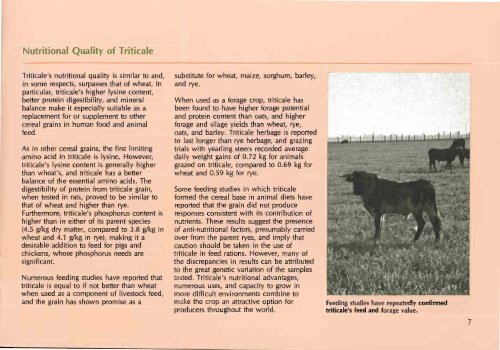U - Search CIMMYT repository
U - Search CIMMYT repository
U - Search CIMMYT repository
Create successful ePaper yourself
Turn your PDF publications into a flip-book with our unique Google optimized e-Paper software.
Nutritional Quality of Triticale<br />
Triticale's nutritional quality is similar to and,<br />
in some respects, surpasses that of wheat. In<br />
particular, triticale's higher lysine content,<br />
better protein digestibility, and mineral<br />
balance make it especially suitable as a<br />
replacement for or supplement to other<br />
cereal grains in human food and animal<br />
feed.<br />
As in other cereal grains, the first limiting<br />
amino acid in triticale is lysine. However,<br />
triticale's lysine content is generally higher<br />
than wheat'S, and triticale has a better<br />
balance of the essential amino acids. The<br />
digestibility of protein from triticale grain,<br />
when tested in rats, proved to be similar to<br />
that of wheat and higher than rye.<br />
Furthermore, triticale's phosphorus content is<br />
higher than in either of its parent species<br />
(4.5 g/kg dry matter, compared to 3.8 g/kg in<br />
wheat and 4.1 g/kg in rye), making it a<br />
desirable addition to feed for pigs and<br />
chickens, whose phosphorus needs are<br />
significant.<br />
Numerous feeding studies have reported that<br />
triticale is equal to if not better than wheat<br />
when used as a component of Iivestock feed,<br />
and the grain has shown promise as a<br />
substitute for wheat, maize, sorghum, barley,<br />
and rye.<br />
When used as a forage crop, triticale has<br />
been found to have higher forage potential<br />
and protein content than oats, and higher<br />
forage and silage yields than wheat, rye,<br />
oats, and barley. Triticale herbage is reported<br />
to last longer than rye herbage, and grazing<br />
trials with yearling steers recorded average<br />
daily weight gains of 0.72 kg for animals<br />
grazed on triticale, compared to 0.69 kg for<br />
wheat and 0.59 kg for rye.<br />
Some feeding studies in which triticale<br />
formed the cereal base in animal diets have<br />
reported that the grain did not produce<br />
responses consistent with its contribution of<br />
nutrients. These results suggest the presence<br />
of anti-nutritional factors, presumably carried<br />
over from the parent ryes, and imply that<br />
caution should be taken in the use of<br />
triticale in feed rations. However, many of<br />
the discrepancies in results can be attributed<br />
to the great genetic variation of the samples<br />
tested. Triticale's nutritional advantages,<br />
numerous uses, and capacity to grow in<br />
more difficult environments combine to<br />
make the crop an attractive option for<br />
producers throughout the world.<br />
Feeding studies have repeatedly confirmed<br />
triticale's feed and forage value.<br />
7

















